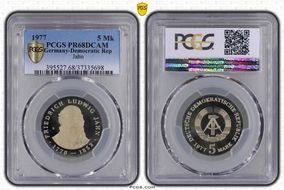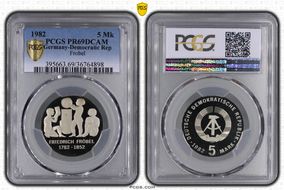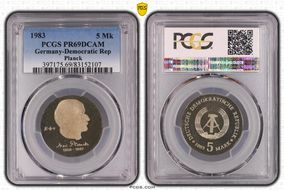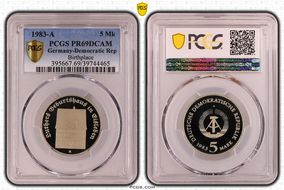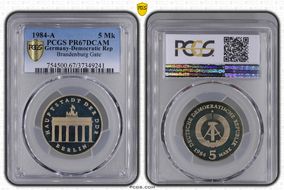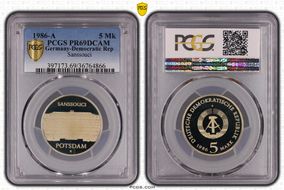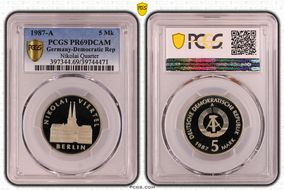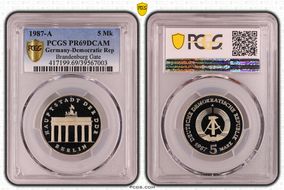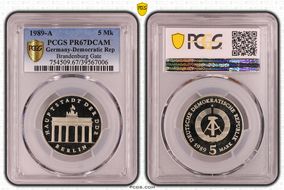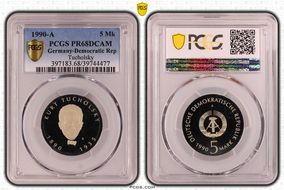Koenigsberg Collection | E. Germany 5 Mark PR | Commemoratives 的钱币相册
Germany-Democratic Republic | KM# 64 | J-1564 | Commemorating the 125th obit of Friedrich Ludwig Jahn Friedrich Ludwig Jahn (11 August 1778 – 15 October 1852) was a German gymnastics educator and nationalist whose writing is credited with the founding of the German gymnastics (Turner) movement as well as influencing the German Campaign of 1813, during which a coalition of German states effectively ended the occupation of Napoleon's First French Empire. His admirers know him as Turnvater Jahn, roughly meaning "father of gymnastics" Jahn.
Germany-Democratic Republic | KM# 64 | J-1564 | Commemorating the 125th obit of Friedrich Ludwig Jahn Friedrich Ludwig Jahn (11 August 1778 – 15 October 1852) was a German gymnastics educator and nationalist whose writing is credited with the founding of the German gymnastics (Turner) movement as well as influencing the German Campaign of 1813, during which a coalition of German states effectively ended the occupation of Napoleon's First French Empire. His admirers know him as Turnvater Jahn, roughly meaning "father of gymnastics" Jahn.
Germany-Democratic Republic | KM# 84 | J-1584 | Commemorating the 200th birthday of Friedrich Wilhelm August Fröbel Friedrich Wilhelm August Fröbel or Froebel (German: [ˈfʁiːdʁɪç ˈvɪlhɛlm ˈʔaʊɡʊst ˈfʁøːbl̩] (About this soundlisten); 21 April 1782 – 21 June 1852) was a German pedagogue, a student of Johann Heinrich Pestalozzi, who laid the foundation for modern education based on the recognition that children have unique needs and capabilities. He created the concept of the kindergarten and coined the word, which soon entered the English language as well. He also developed the educational toys known as Froebel gifts.
Germany-Democratic Republic | KM# 84 | J-1584 | Commemorating the 200th birthday of Friedrich Wilhelm August Fröbel Friedrich Wilhelm August Fröbel or Froebel (German: [ˈfʁiːdʁɪç ˈvɪlhɛlm ˈʔaʊɡʊst ˈfʁøːbl̩] (About this soundlisten); 21 April 1782 – 21 June 1852) was a German pedagogue, a student of Johann Heinrich Pestalozzi, who laid the foundation for modern education based on the recognition that children have unique needs and capabilities. He created the concept of the kindergarten and coined the word, which soon entered the English language as well. He also developed the educational toys known as Froebel gifts.
Germany-Democratic Republic | KM# 91 | J-1594 | Commemorating the 125th birthday of Max Planck Max Karl Ernst Ludwig Planck, (23 April 1858 – 4 October 1947) was a German theoretical physicist whose discovery of energy quanta won him the Nobel Prize in Physics in 1918. Planck made many contributions to theoretical physics, but his fame as a physicist rests primarily on his role as the originator of quantum theory, which revolutionized human understanding of atomic and subatomic processes. In 1948 the German scientific institution Kaiser Wilhelm Society (of which Planck was twice president) was renamed Max Planck Society (MPS). The MPS now includes 83 institutions representing a wide range of scientific directions.
Germany-Democratic Republic | KM# 91 | J-1594 | Commemorating the 125th birthday of Max Planck Max Karl Ernst Ludwig Planck, (23 April 1858 – 4 October 1947) was a German theoretical physicist whose discovery of energy quanta won him the Nobel Prize in Physics in 1918. Planck made many contributions to theoretical physics, but his fame as a physicist rests primarily on his role as the originator of quantum theory, which revolutionized human understanding of atomic and subatomic processes. In 1948 the German scientific institution Kaiser Wilhelm Society (of which Planck was twice president) was renamed Max Planck Society (MPS). The MPS now includes 83 institutions representing a wide range of scientific directions.
Germany-Democratic Republic | KM# 90 | J-1590 | Martin Luther's birthplace Martin Luther, O.S.A. (/ˈluːθər/; German: [ˈmaʁtiːn ˈlʊtɐ] (About this soundlisten); 10 November 1483 – 18 February 1546) was a German professor of theology, priest, author, composer, Augustinian monk, and a seminal figure in the Reformation. Luther was ordained to the priesthood in 1507. He came to reject several teachings and practices of the Roman Catholic Church; in particular, he disputed the view on indulgences. Luther proposed an academic discussion of the practice and efficacy of indulgences in his Ninety-five Theses of 1517. His refusal to renounce all of his writings at the demand of Pope Leo X in 1520 and the Holy Roman Emperor Charles V at the Diet of Worms in 1521 resulted in his excommunication by the pope and condemnation as an outlaw by the Holy Roman Emperor.
Germany-Democratic Republic | KM# 90 | J-1590 | Martin Luther's birthplace Martin Luther, O.S.A. (/ˈluːθər/; German: [ˈmaʁtiːn ˈlʊtɐ] (About this soundlisten); 10 November 1483 – 18 February 1546) was a German professor of theology, priest, author, composer, Augustinian monk, and a seminal figure in the Reformation. Luther was ordained to the priesthood in 1507. He came to reject several teachings and practices of the Roman Catholic Church; in particular, he disputed the view on indulgences. Luther proposed an academic discussion of the practice and efficacy of indulgences in his Ninety-five Theses of 1517. His refusal to renounce all of his writings at the demand of Pope Leo X in 1520 and the Holy Roman Emperor Charles V at the Diet of Worms in 1521 resulted in his excommunication by the pope and condemnation as an outlaw by the Holy Roman Emperor.
Germany-Democratic Republic | KM# 29 | J-1536 | Capital City of the GDR, Brandenburg Gate The Brandenburg Gate (German: Brandenburger Tor; [ˈbʁandn̩bʊɐ̯gɐ ˈtoːɐ̯]) is an 18th-century neoclassical monument in Berlin, built on the orders of Prussian king Frederick William II after the temporary restoration of order during the Batavian Revolution. One of the best-known landmarks of Germany, it was built on the site of a former city gate that marked the start of the road from Berlin to the town of Brandenburg an der Havel, which used to be capital of the Margraviate of Brandenburg. It is located in the western part of the city centre of Berlin within Mitte, at the junction of Unter den Linden and Ebertstraße, immediately west of the Pariser Platz. One block to the north stands the Reichstag building, which houses the German parliament (Bundestag). The gate is the monumental entry to Unter den Linden, a boulevard of linden trees which led directly to the royal City Palace of the Prussian monarchs. Throughout its existence, the Brandenburg Gate was often a site for major historical events and is today considered not only as a symbol of the tumultuous history of Europe and Germany, but also of European unity and peace.
Germany-Democratic Republic | KM# 29 | J-1536 | Capital City of the GDR, Brandenburg Gate The Brandenburg Gate (German: Brandenburger Tor; [ˈbʁandn̩bʊɐ̯gɐ ˈtoːɐ̯]) is an 18th-century neoclassical monument in Berlin, built on the orders of Prussian king Frederick William II after the temporary restoration of order during the Batavian Revolution. One of the best-known landmarks of Germany, it was built on the site of a former city gate that marked the start of the road from Berlin to the town of Brandenburg an der Havel, which used to be capital of the Margraviate of Brandenburg. It is located in the western part of the city centre of Berlin within Mitte, at the junction of Unter den Linden and Ebertstraße, immediately west of the Pariser Platz. One block to the north stands the Reichstag building, which houses the German parliament (Bundestag). The gate is the monumental entry to Unter den Linden, a boulevard of linden trees which led directly to the royal City Palace of the Prussian monarchs. Throughout its existence, the Brandenburg Gate was often a site for major historical events and is today considered not only as a symbol of the tumultuous history of Europe and Germany, but also of European unity and peace.
Germany-Democratic Republic | KM# 110 | J-1609 | Sanssouci Sanssouci is a historical building in Potsdam, near Berlin. Built by Frederick the Great, King of Prussia, as his summer palace, it is often counted among the German rivals of Versailles. While Sanssouci is in the more intimate Rococo style and is far smaller than its French Baroque counterpart, it too is notable for the numerous temples and follies in the park. The palace was designed/built by Georg Wenzeslaus von Knobelsdorff between 1745 and 1747 to fulfill King Frederick's need for a private residence where he could relax away from the pomp and ceremony of the Berlin court. The palace's name emphasises this; it is a French phrase (sans souci), which translates as "without concerns", meaning "without worries" or "carefree", symbolising that the palace was a place for relaxation rather than a seat of power. The name in past times reflected a play on words, with the insertion of a comma visible between the words Sans and Souci, viz. Sans, Souci. Kittsteiner theorizes that this could be a philosophical play on words, meaning "without a worry/concern" or it could be some secret personal message which nobody has interpreted, left to posterity by Frederick II.
Germany-Democratic Republic | KM# 110 | J-1609 | Sanssouci Sanssouci is a historical building in Potsdam, near Berlin. Built by Frederick the Great, King of Prussia, as his summer palace, it is often counted among the German rivals of Versailles. While Sanssouci is in the more intimate Rococo style and is far smaller than its French Baroque counterpart, it too is notable for the numerous temples and follies in the park. The palace was designed/built by Georg Wenzeslaus von Knobelsdorff between 1745 and 1747 to fulfill King Frederick's need for a private residence where he could relax away from the pomp and ceremony of the Berlin court. The palace's name emphasises this; it is a French phrase (sans souci), which translates as "without concerns", meaning "without worries" or "carefree", symbolising that the palace was a place for relaxation rather than a seat of power. The name in past times reflected a play on words, with the insertion of a comma visible between the words Sans and Souci, viz. Sans, Souci. Kittsteiner theorizes that this could be a philosophical play on words, meaning "without a worry/concern" or it could be some secret personal message which nobody has interpreted, left to posterity by Frederick II.
Germany-Democratic Republic | KM# 114 | J-1613 | Nikolai Quarter in Berlin Founded about 1200, the Nikolaiviertel (Nicholas' Quarter) of Alt-Berlin, together with nearby Cölln, jointly make up the reconstructed historical heart of the German capital of Berlin. It is located in Mitte locality (in the homonymous district), five minutes away from Alexanderplatz.
Germany-Democratic Republic | KM# 114 | J-1613 | Nikolai Quarter in Berlin Founded about 1200, the Nikolaiviertel (Nicholas' Quarter) of Alt-Berlin, together with nearby Cölln, jointly make up the reconstructed historical heart of the German capital of Berlin. It is located in Mitte locality (in the homonymous district), five minutes away from Alexanderplatz.
Germany-Democratic Republic | KM# 115 | J- 1614 | Red City Hall in Berlin The Rotes Rathaus (German: [ˈʁoːtəs ˈʁaːtˌhaʊs], Red City Hall) is the town hall of Berlin, located in the Mitte district on Rathausstraße near Alexanderplatz. It is the home to the governing mayor and the government (the Senate of Berlin) of the state of Berlin. The name of the landmark building dates from the façade design with red clinker bricks.
Germany-Democratic Republic | KM# 115 | J- 1614 | Red City Hall in Berlin The Rotes Rathaus (German: [ˈʁoːtəs ˈʁaːtˌhaʊs], Red City Hall) is the town hall of Berlin, located in the Mitte district on Rathausstraße near Alexanderplatz. It is the home to the governing mayor and the government (the Senate of Berlin) of the state of Berlin. The name of the landmark building dates from the façade design with red clinker bricks.
Germany-Democratic Republic | KM# 29 | J-1536 | Capital City of the GDR, Brandenburg Gate The Brandenburg Gate (German: Brandenburger Tor; [ˈbʁandn̩bʊɐ̯gɐ ˈtoːɐ̯]) is an 18th-century neoclassical monument in Berlin, built on the orders of Prussian king Frederick William II after the temporary restoration of order during the Batavian Revolution. One of the best-known landmarks of Germany, it was built on the site of a former city gate that marked the start of the road from Berlin to the town of Brandenburg an der Havel, which used to be capital of the Margraviate of Brandenburg. It is located in the western part of the city centre of Berlin within Mitte, at the junction of Unter den Linden and Ebertstraße, immediately west of the Pariser Platz. One block to the north stands the Reichstag building, which houses the German parliament (Bundestag). The gate is the monumental entry to Unter den Linden, a boulevard of linden trees which led directly to the royal City Palace of the Prussian monarchs. Throughout its existence, the Brandenburg Gate was often a site for major historical events and is today considered not only as a symbol of the tumultuous history of Europe and Germany, but also of European unity and peace.
Germany-Democratic Republic | KM# 29 | J-1536 | Capital City of the GDR, Brandenburg Gate The Brandenburg Gate (German: Brandenburger Tor; [ˈbʁandn̩bʊɐ̯gɐ ˈtoːɐ̯]) is an 18th-century neoclassical monument in Berlin, built on the orders of Prussian king Frederick William II after the temporary restoration of order during the Batavian Revolution. One of the best-known landmarks of Germany, it was built on the site of a former city gate that marked the start of the road from Berlin to the town of Brandenburg an der Havel, which used to be capital of the Margraviate of Brandenburg. It is located in the western part of the city centre of Berlin within Mitte, at the junction of Unter den Linden and Ebertstraße, immediately west of the Pariser Platz. One block to the north stands the Reichstag building, which houses the German parliament (Bundestag). The gate is the monumental entry to Unter den Linden, a boulevard of linden trees which led directly to the royal City Palace of the Prussian monarchs. Throughout its existence, the Brandenburg Gate was often a site for major historical events and is today considered not only as a symbol of the tumultuous history of Europe and Germany, but also of European unity and peace.
Germany-Democratic Republic | KM# 120 | J-1618 | Commemorating the 150 anniversary of the first german railroad The locomotive Saxonia was operated by the Leipzig–Dresden Railway Company (Leipzig–Dresdner Eisenbahn-Compagnie or LDE) and was the first practical working steam locomotive built in Germany. Its name means Saxony in Latin.
Germany-Democratic Republic | KM# 121 | J-1619 | Rostock Port Rostock Port is a large German port on the Baltic Sea, it is located on the Unterwarnow estuary in the city of Rostock. Most of the port infrastructure is owned by Rostock Port GmbH (until 2016: Hafen-Entwicklungsgesellschaft Rostock mbH "HERO"), a joint venture between the state of Mecklenburg-Vorpommern (25.1%) and the Hanseatic City of Rostock (74.9%). The port operations are carried out by Euroports Germany GmbH & Co. and other private companies. With a total throughput of 28.8 million tons (2017), the ports of Rostock is the fourth largest German port (after Port of Hamburg, Ports of Bremen and Wilhelmshaven port). The ports of Rostock include the Rostock seaport located on the east side of the Unterwarnow (built since the 1960s), the chemical port for Yara located east of it at Breitling, the independent freight and fishing port (RFH) in the west side of the Unterwarnow, the cruise terminal at the passenger quay in Warnemünde and other smaller facilities such as the Maritime Industrial Park (MAGEB) and the Quay of Alba Nord north of the RFH and the Rostock city port, where goods are handled no more.
Germany-Democratic Republic | KM# 29 | J-1536 | Capital City of the GDR, Brandenburg Gate The Brandenburg Gate (German: Brandenburger Tor; [ˈbʁandn̩bʊɐ̯gɐ ˈtoːɐ̯]) is an 18th-century neoclassical monument in Berlin, built on the orders of Prussian king Frederick William II after the temporary restoration of order during the Batavian Revolution. One of the best-known landmarks of Germany, it was built on the site of a former city gate that marked the start of the road from Berlin to the town of Brandenburg an der Havel, which used to be capital of the Margraviate of Brandenburg. It is located in the western part of the city centre of Berlin within Mitte, at the junction of Unter den Linden and Ebertstraße, immediately west of the Pariser Platz. One block to the north stands the Reichstag building, which houses the German parliament (Bundestag). The gate is the monumental entry to Unter den Linden, a boulevard of linden trees which led directly to the royal City Palace of the Prussian monarchs. Throughout its existence, the Brandenburg Gate was often a site for major historical events and is today considered not only as a symbol of the tumultuous history of Europe and Germany, but also of European unity and peace.
Germany-Democratic Republic | KM# 29 | J-1536 | Capital City of the GDR, Brandenburg Gate The Brandenburg Gate (German: Brandenburger Tor; [ˈbʁandn̩bʊɐ̯gɐ ˈtoːɐ̯]) is an 18th-century neoclassical monument in Berlin, built on the orders of Prussian king Frederick William II after the temporary restoration of order during the Batavian Revolution. One of the best-known landmarks of Germany, it was built on the site of a former city gate that marked the start of the road from Berlin to the town of Brandenburg an der Havel, which used to be capital of the Margraviate of Brandenburg. It is located in the western part of the city centre of Berlin within Mitte, at the junction of Unter den Linden and Ebertstraße, immediately west of the Pariser Platz. One block to the north stands the Reichstag building, which houses the German parliament (Bundestag). The gate is the monumental entry to Unter den Linden, a boulevard of linden trees which led directly to the royal City Palace of the Prussian monarchs. Throughout its existence, the Brandenburg Gate was often a site for major historical events and is today considered not only as a symbol of the tumultuous history of Europe and Germany, but also of European unity and peace.
Germany-Democratic Republic | KM# 129 | J-1626 | Katharinenkloster Zwickau Zwickau (German pronunciation: [ˈtsvɪkaʊ]) is a town in Saxony, Germany, and the capital of the Zwickau district. It is situated in a valley at the foot of the Erzgebirge mountains, is part of Central Germany (cultural area) and is geographically linked to the urban areas of Leipzig-Halle, Dresden and Chemnitz. The town has approximately 100,000 inhabitants. From 1834 until 1952 Zwickau was the seat of the government of the south-western region of Saxony. Zwickau is the centre of the Saxon automotive industry, with a tradition over one hundred years old, including car makers Horch, Audi, Auto Union, Trabant and Volkswagen. The University of Applied Sciences Zwickau (Westsächsische Hochschule Zwickau) trains automotive engineers.
Germany-Democratic Republic | KM# 131 | J-1628 | Commemorating the 100th birthday of Carl von Ossietzky Carl von Ossietzky (German: [kʰaɐ̯l fɔn ʔɔˈsjɛt͡skiː]; 3 October 1889 – 4 May 1938) was a German journalist and pacifist. He was the recipient of the 1935 Nobel Peace Prize for his work in exposing the clandestine German re-armament. As editor-in-chief of the magazine Die Weltbühne, Ossietzky published a series of exposés in the late 1920s, detailing Germany's violation of the Treaty of Versailles by rebuilding an air force (the predecessor of the Luftwaffe) and training pilots in the Soviet Union. He was convicted of treason and espionage in 1931 and sentenced to eighteen months in prison, but was granted amnesty in December 1932. Ossietzky continued to be a vocal critic against German militarism after the Nazis' rise to power. Following the 1933 Reichstag fire, Ossietzky was again arrested and sent to the Esterwegen concentration camp near Oldenburg. In 1936, he was awarded the 1935 Nobel Peace Prize, but was forbidden from travelling to Norway and accepting the prize. After enduring years of mistreatment and torture in various camps, Ossietzky died of tuberculosis in 1938 in a Berlin hospital.
Germany-Democratic Republic | KM# 131 | J-1628 | Commemorating the 100th birthday of Carl von Ossietzky Carl von Ossietzky (German: [kʰaɐ̯l fɔn ʔɔˈsjɛt͡skiː]; 3 October 1889 – 4 May 1938) was a German journalist and pacifist. He was the recipient of the 1935 Nobel Peace Prize for his work in exposing the clandestine German re-armament. As editor-in-chief of the magazine Die Weltbühne, Ossietzky published a series of exposés in the late 1920s, detailing Germany's violation of the Treaty of Versailles by rebuilding an air force (the predecessor of the Luftwaffe) and training pilots in the Soviet Union. He was convicted of treason and espionage in 1931 and sentenced to eighteen months in prison, but was granted amnesty in December 1932. Ossietzky continued to be a vocal critic against German militarism after the Nazis' rise to power. Following the 1933 Reichstag fire, Ossietzky was again arrested and sent to the Esterwegen concentration camp near Oldenburg. In 1936, he was awarded the 1935 Nobel Peace Prize, but was forbidden from travelling to Norway and accepting the prize. After enduring years of mistreatment and torture in various camps, Ossietzky died of tuberculosis in 1938 in a Berlin hospital.
Germany-Democratic Republic | KM# 133 | J-1633 | Commemorating the 100th birthday of Kurt Tucholsky Kurt Tucholsky (German: [kʊʁt tu.ˈxɔls.ki]; 9 January 1890 – 21 December 1935) was a German journalist, satirist, and writer. He also wrote under the pseudonyms Kaspar Hauser (after the historical figure), Peter Panter, Theobald Tiger and Ignaz Wrobel. He was silent after 1932 and probably committed suicide. Tucholsky was one of the most important journalists of the Weimar Republic. As a politically engaged journalist and temporary co-editor of the weekly magazine Die Weltbühne he proved himself to be a social critic in the tradition of Heinrich Heine. He was simultaneously a satirist, an author of satirical political revues, a songwriter and a poet. He saw himself as a left-wing democrat and pacifist and warned against anti-democratic tendencies – above all in politics, the military – and the threat of National Socialism. His fears were confirmed when the Nazis came to power in January 1933. In May of that year he was among the authors whose works were banned as "un-German", and burned; he was also among the first authors and intellectuals whose German citizenship was revoked.
Germany-Democratic Republic | KM# 133 | J-1633 | Commemorating the 100th birthday of Kurt Tucholsky Kurt Tucholsky (German: [kʊʁt tu.ˈxɔls.ki]; 9 January 1890 – 21 December 1935) was a German journalist, satirist, and writer. He also wrote under the pseudonyms Kaspar Hauser (after the historical figure), Peter Panter, Theobald Tiger and Ignaz Wrobel. He was silent after 1932 and probably committed suicide. Tucholsky was one of the most important journalists of the Weimar Republic. As a politically engaged journalist and temporary co-editor of the weekly magazine Die Weltbühne he proved himself to be a social critic in the tradition of Heinrich Heine. He was simultaneously a satirist, an author of satirical political revues, a songwriter and a poet. He saw himself as a left-wing democrat and pacifist and warned against anti-democratic tendencies – above all in politics, the military – and the threat of National Socialism. His fears were confirmed when the Nazis came to power in January 1933. In May of that year he was among the authors whose works were banned as "un-German", and burned; he was also among the first authors and intellectuals whose German citizenship was revoked.
Germany-Democratic Republic | KM# 135 | J-1632 | Zeughaus Berlin The Zeughaus (English: Arsenal) is a listed building and the oldest structure on Unter den Linden boulevard in the historic centre of Berlin. Erected from 1695 to 1706 according to plans by Johann Arnold Nering, Martin Grünberg, Andreas Schlüter and Jean de Bodt in Baroque style, it was later converted into a Prussian Hall of Fame. Damaged during the Allied bombing in World War II, the Zeughaus was rebuilt from 1949 to 1967 as part of the Forum Fridericianum. Since 2003, it has been home to the Deutsches Historisches Museum (German Historic Museum).




















